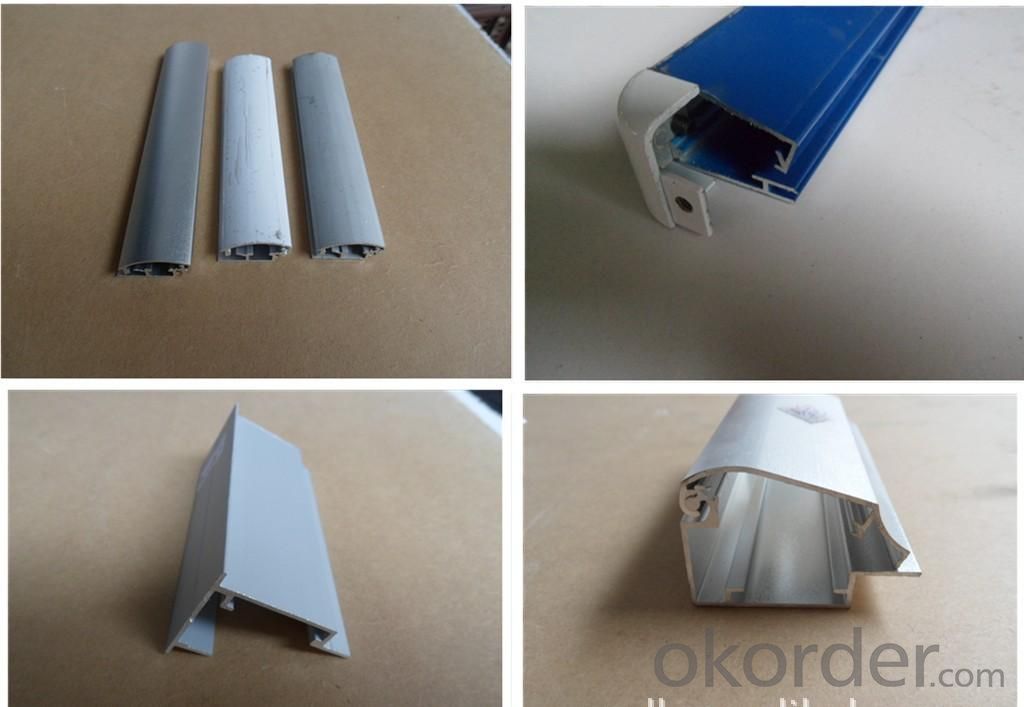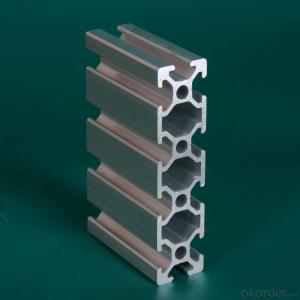Aluminium Extrusion Profiles For Construction
- Loading Port:
- Shanghai
- Payment Terms:
- TT OR LC
- Min Order Qty:
- 2 m.t.
- Supply Capability:
- 50000 m.t./month
OKorder Service Pledge
OKorder Financial Service
You Might Also Like
Item specifice
Product Description
Product Name | Aluminium Extrusion Profiles For Construction |
Alloy | Al 6063 T5 /T6 or 6061 T4/T6 or as customers' need |
Surface | Aluminum profiles of mill finish, powder coating, anodizing, polishing, sand blasting, electrophoresis and wood color. |
Profile shape | According to drawings or re-design as requested or market needs. |
Price | Based on Aluminum Ingot Price + Process fee |
Payment term | T/C T/T 30% deposit and 70% pay against copy of B/L |
Certificate | ISO9001 ISO14001 |
Warranty | 1. GB5237-2008 equal to EN12020-1.2(2001); 2. Within 15 years without powder peeling off; |

Product Advantages
1. Plenty of surface treatments for your choice, for example oxidation, electrophoresis and static powder coating, etc.
2. Strict control for surface finish, very little scratch.
3. Accurate mold as well as accurate size.
4. Standard alloy composition
5. Both ends of the profiles are very plain and with no burr.
FAQ
1. What is your main product?
We can supply the aluminium complete system, including aluminum billets, aluminum profile for windows and doors, aluminum for curtain wall, alumimun framwork, and kinds of aluminum windows and doors.
2. What’s your price?
The price is based on buyer's specific requirement, so please provide below information to help us quote exact price to you.
3. What is your payment term?
30% - 50% down payment, the balance payment against, and L/C is available.
- Q:Can aluminum profiles be an alternative to steel or iron?
- Yes, aluminum profiles can be a viable alternative to steel or iron in certain applications. Aluminum is lightweight, corrosion-resistant, and has high strength-to-weight ratio, making it suitable for various industries including aerospace, automotive, construction, and marine. Additionally, aluminum profiles offer excellent thermal and electrical conductivity properties. However, steel or iron may still be preferred in applications requiring higher tensile strength or extreme durability. Ultimately, the choice between aluminum profiles and steel or iron depends on the specific requirements and constraints of the project.
- Q:Are aluminum profiles suitable for cleanroom applications?
- Yes, aluminum profiles are highly suitable for cleanroom applications. Aluminum is a non-corrosive and lightweight material that is easy to clean and maintain. It offers excellent strength and structural stability, making it ideal for constructing cleanroom walls, partitions, and equipment. Additionally, aluminum profiles can be easily customized and integrated with cleanroom components such as doors, windows, and ceiling grids. Overall, aluminum profiles provide the necessary properties to meet the stringent requirements of cleanroom environments.
- Q:How do aluminum profiles perform in vibration isolation applications?
- Aluminum profiles are commonly used in vibration isolation applications due to their excellent mechanical properties. They exhibit high stiffness, durability, and damping characteristics, which help in effectively reducing vibrations. Additionally, their lightweight nature allows for easy installation and portability. Overall, aluminum profiles perform well in vibration isolation applications, providing reliable and efficient solutions.
- Q:How do aluminum profiles compare to other types of materials?
- Aluminum profiles have several advantages over other types of materials. Firstly, aluminum is lightweight, making it easier to handle and transport. It is also highly resistant to corrosion, making it ideal for outdoor or high-moisture environments. Additionally, aluminum profiles offer excellent strength-to-weight ratio, providing structural stability without unnecessary weight. Moreover, aluminum is a highly versatile material that can be easily shaped and customized to meet specific design requirements. Lastly, aluminum is sustainable and recyclable, making it an environmentally friendly choice. Overall, aluminum profiles offer numerous benefits in terms of durability, versatility, and sustainability compared to other materials.
- Q:What are the different types of corner connectors used with aluminum profiles?
- There are several different types of corner connectors used with aluminum profiles, including corner brackets, corner blocks, T-slot corner connectors, and corner gussets. These connectors help to create strong and stable joints between aluminum profiles, allowing for the construction of various structures and frameworks.
- Q:It is now the most urban rail trains, as well as the manufacturing methods and processes of large parts profiles used in the manufacture of CRH3 type emus.
- Extrusion; preheating; mold preheating; extrusion quality inspection (optical projection measurement); cutting; heat treatment; quality assurance tests; mechanical properties; cross sectional metallography; electrical conductivity) shipment..
- Q:What are the different surface embossing options for aluminum profiles?
- There are several surface embossing options available for aluminum profiles, each offering unique textures and patterns. Some of the most commonly used options include: 1. Diamond pattern: This embossing option creates a diamond-shaped pattern on the surface of the aluminum profile. It provides a visually appealing texture and enhances the grip of the profile, making it suitable for applications that require slip resistance. 2. Stucco pattern: Stucco embossing creates a textured surface with small, raised bumps. This pattern is commonly used in applications where aesthetics are important, such as architectural facades or interior design elements. 3. Hammer tone pattern: This embossing option creates a hammered texture on the surface of the aluminum profile. It gives a unique and rustic appearance, making it popular for decorative applications like furniture or light fixtures. 4. Wood grain pattern: Wood grain embossing mimics the texture and appearance of natural wood. This option is often chosen to achieve a more traditional or natural look in applications like window frames or doors. 5. Linen pattern: Linen embossing creates a subtle, fabric-like texture on the surface of the aluminum profile. This pattern is commonly used in applications that require a sophisticated and elegant finish, such as interior decorative panels or cabinet doors. It's important to note that these embossing options can be combined or customized to suit specific design requirements. Manufacturers may offer additional embossing options, allowing customers to choose from a wide range of patterns and textures to achieve their desired aesthetic and functional goals.
- Q:How many tons of aluminum can be produced by a ton of aluminium ingots?
- There are many factors to consider in this problem, and in the case of insufficient conditions, we can only compare them by using the hypothesis method. But personally think that a meal of aluminum ingots can definitely make a full or more than a ton of aluminum. The product is Aluminum Alloy, pure aluminum processed into Aluminum Alloy, so the process is sure to add other metal components (such as silicon, iron, copper, manganese, magnesium, zinc, chromium, titanium), assuming that the pure aluminum ingots is one hundred percent, so in the process of loss amount the amount of aluminum must be smaller than the metal, so the results will come out
- Q:Can aluminum profiles be used in the production of laboratory equipment?
- Yes, aluminum profiles can be used in the production of laboratory equipment. Aluminum is a versatile and widely used material in various industries, including laboratory equipment manufacturing. Aluminum profiles offer several advantages for laboratory equipment production. Firstly, aluminum is lightweight yet strong, making it ideal for constructing equipment that needs to be portable or moved frequently within the laboratory. Its lightweight nature also reduces the strain on laboratory personnel when handling and transporting the equipment. Secondly, aluminum profiles can be easily shaped and molded into various forms and sizes, allowing for the customization of laboratory equipment to meet specific requirements. This flexibility in design enables the production of equipment with complex shapes and structures, ensuring optimal functionality and efficiency. Additionally, aluminum is corrosion-resistant, which is crucial in laboratory settings where exposure to chemicals and liquids is common. This property helps to extend the lifespan of the equipment and ensures it remains in good condition even after prolonged use. Furthermore, aluminum profiles can be anodized or coated to provide additional protection against wear, scratches, and other types of damage. This makes the equipment more durable and easier to clean, maintaining the required hygiene standards in laboratories. Lastly, aluminum is a highly conductive material, making it suitable for applications that require heat transfer or electrical conductivity. This property is advantageous for laboratory equipment such as heating plates, heat sinks, or electrical circuit components. In conclusion, aluminum profiles can indeed be used in the production of laboratory equipment. Their lightweight, malleable, corrosion-resistant, and conductive properties make them a suitable choice for manufacturing various types of laboratory equipment, ensuring durability, functionality, and ease of use.
- Q:How do aluminum profiles handle extreme weather conditions?
- Aluminum profiles are known for their exceptional durability and resilience, making them highly capable of handling extreme weather conditions. Due to their inherent corrosion resistance, aluminum profiles can withstand harsh weather elements such as heavy rain, snow, extreme temperature fluctuations, and even high levels of UV radiation without corroding or deteriorating. One of the key attributes of aluminum is its ability to create a protective oxide layer on its surface, known as aluminum oxide. This layer acts as a natural barrier, shielding the metal from moisture, salt, and other corrosive agents present in the atmosphere. As a result, aluminum profiles remain unaffected by rain or snow, and they do not rust or corrode like other metals. Furthermore, aluminum's thermal conductivity allows it to quickly dissipate heat, preventing any damage caused by extreme temperature variations. Whether exposed to scorching heat or freezing cold, aluminum profiles expand and contract minimally, which helps maintain their structural integrity and prevents warping or cracking. Moreover, aluminum profiles can withstand high wind loads, making them suitable for areas prone to hurricanes, tornadoes, or strong gusts. Their lightweight yet sturdy nature enables them to withstand significant pressure without bending or breaking. In terms of UV radiation, aluminum profiles have excellent resistance to fading and discoloration. They can effectively endure prolonged exposure to sunlight without losing their original color or surface finish. This makes them an ideal choice for outdoor applications, such as windows, doors, and facades, where they remain visually appealing and structurally sound even in extreme weather conditions. Overall, aluminum profiles exhibit remarkable durability, corrosion resistance, thermal stability, and resistance to UV radiation, allowing them to effectively handle and withstand the challenges posed by extreme weather conditions.
1. Manufacturer Overview |
|
|---|---|
| Location | |
| Year Established | |
| Annual Output Value | |
| Main Markets | |
| Company Certifications | |
2. Manufacturer Certificates |
|
|---|---|
| a) Certification Name | |
| Range | |
| Reference | |
| Validity Period | |
3. Manufacturer Capability |
|
|---|---|
| a)Trade Capacity | |
| Nearest Port | |
| Export Percentage | |
| No.of Employees in Trade Department | |
| Language Spoken: | |
| b)Factory Information | |
| Factory Size: | |
| No. of Production Lines | |
| Contract Manufacturing | |
| Product Price Range | |
Send your message to us
Aluminium Extrusion Profiles For Construction
- Loading Port:
- Shanghai
- Payment Terms:
- TT OR LC
- Min Order Qty:
- 2 m.t.
- Supply Capability:
- 50000 m.t./month
OKorder Service Pledge
OKorder Financial Service
Similar products
New products
Hot products
Related keywords






























